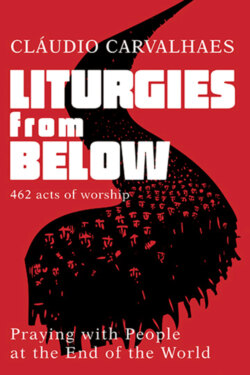Читать книгу Liturgies from Below - UK Edition - Carvalhaes Claudio - Страница 16
На сайте Литреса книга снята с продажи.
How Are We to Pray?
ОглавлениеThis prayer book offers an alternative to both the traditional prayer books of Christian liturgies and neo-Pentecostal cultic prayers. It intertwines traditional Christian liturgies and neo-Pentecostal prayers. Based on a gospel insistence that we must get closer to the poorest and the abandoned in the world, this book is intended to help us pray with those who are suffering the psychological, social, economic, sexual, and racial violence of our times. Thus, the main question here is: How are we to pray with the unwanted of the world? How can our prayers not only address the disasters of the world and the killing of people everywhere but also, in God’s love, offer hope and actions of transformation? And in that way of praying, how do we get to the point where we can see our own vulnerability, our own incompleteness, our own frailty, and our own shakable ontological structure and impossibility to deal with life itself?
Once in a worship class, a guest speaker told my students that we needed to pray the established, written prayers of the church for at least twenty years before we were able to pray our own newly composed prayers. Does such a rule still apply? I do not think so. A new movement is required for this time: not to abandon the prayers of the church but to also pray new prayers in new ways, for others and ourselves, in a constant movement of God’s grace into an expansive mindfulness, transforming and recreating ourselves and the world. This will mean learning how to pray differently, to be faithful to Jesus in these devastating times by praying with and for the unwanted—those who are the “undercommons,”8 including not only humans but also the whole earth and other animals, because their conditions of living are also the conditions of existence for all of us.
Through our collective prayers, with those who we are called to listen to, serve, and fight for, God calls us to live our faith in much deeper ways, understand our world in broader ways, and make a radical commitment with the poor in the name of God. Through prayers, we can envision a radical moral imagination of new worlds! By the grace of God, we can birth these new worlds through ora et labora—our prayers and our work in solidarity.
A lost voice. Squatting in my little street corner this very dark night. It is cold and the darkness is scary. Who can hold me—the hand of God. Is there a God out there? God, if you are there—if you can hear me, hold me through the night. I really want to sleep, but my belly is rumbling. Please don’t let them find me here, stop them from taking and hurting me. God—if you are there—hear my voice!9
1.Find many additional prayers from this project at http://reimaginingworship.com.
2.https://www.cwmission.org.
3.https://www.oxfam.org/en/press-releases/worlds-billionaires-have-more-wealth-46-billion-people.
4.Donna Haraway, “Anthropocene, Capitalocene, Plantationocene, Chthulucene: Making Kin,” Environmental Humanities, vol. 6, 2015; https://environmentalhumanities.org/arch/vol6/6.7.pdf.
5.Paul Holmer in The Grammar of Faith shows how prayer consists of structural languages that shape people’s ways of being. The grammar of faith for him is marked by language of faith and not language about faith. Theology for him is done by the one praying and not a comment or reflection on proper theology done elsewhere. Theology is a personal event. He says, “Theology must always move towards a present-tense, first-person mood” (p. 24). Following Holmer, we believe that every individual prays from their own life experiences and through their own lives. Their prayers are the forms and contents of theology. In other words, theology happens in the moment when one is praying, with their self/collective presence, the conditions, quality, and limitations of their lives. When we pray in places of hurt and violence, our theologies pulse with sweat and blood, and a new grammar of faith ensues. See Paul L. Holmer, The Grammar of Faith (San Francisco: Harper and Row, 1978).
6.Cláudio Carvalhaes, Praying With: A Christian Orientation of the Heart (Eugene, OR: Cascade, 2021), forthcoming.
7.Jung Mo Sung, Desire, Market, and Religion (London: SCM Press, 2012); “Christianity Reborn: A Century After Its Birth Pentecostalism Is Redrawing the Religious Map of the World and Undermining the Notion That Modernity Is Secular,” The Economist, December 19, 2006, https://www.economist.com/special-report/2006/12/19/christianity-reborn.
8.Stefano Harney and Fred Moten, The Undercommons: Fugitive Planning & Black Study (Durham: Duke University Press, 2013), Kindle Locations 26–30, Kindle Edition.
9.Find many additional prayers from this project at http://reimaginingworship.com.
